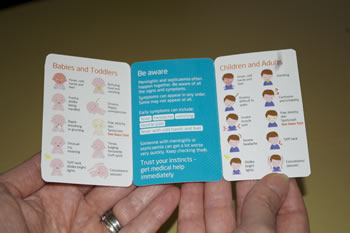Do You Recognise The Signs Of Meningitis?
Meningitis Now issues warning as children start back at school for the new term
 September sees the start of the meningitis peak season, so the charity is urging parents, students and teachers to be vigilant to the signs and symptoms and download its free phone app or request a symptoms card.
September sees the start of the meningitis peak season, so the charity is urging parents, students and teachers to be vigilant to the signs and symptoms and download its free phone app or request a symptoms card.
While children under 5 are most ‘at risk’ from meningitis, teenagers and students are the second most ‘at risk’ group (aged 15 – 23 years). It is estimated that 10% of the population carry the bacteria which can cause meningitis and septicaemia (blood poisoning), but this increases to about 25% for students.
The meningitis risk increases during the colder months as people spend more time indoors, closer to others; meaning germs are spread more easily. Fighting common infections like colds and flu weakens immune systems, leaving them more vulnerable to the disease.
Sue Davie, Chief Executive of Meningitis Now, said:
“Meningitis can be a difficult disease to spot – particularly at this time of year – as many of its early symptoms can be similar to those of flu. We urge everyone to download our app or get a card, familiarise themselves with the symptoms, trust their instincts and get urgent medical help if concerned. Doing this could save yours or a loved one’s life.”
 Every year about 3,200 cases of bacterial meningitis and septicaemia are reported in the UK – leaving 10% of victims dead and 15% of those who survive with severe after-effects such as brain damage, hearing and sight loss and, where septicaemia has occurred, limb loss and scarring.
Every year about 3,200 cases of bacterial meningitis and septicaemia are reported in the UK – leaving 10% of victims dead and 15% of those who survive with severe after-effects such as brain damage, hearing and sight loss and, where septicaemia has occurred, limb loss and scarring.
It is a disease that can kill within hours, so knowledge of the symptoms, vigilance and quick action are vital.
Symptoms can include fever with cold hands and feet, vomiting, headache, stiff neck, dislike of bright light, joint or muscle pain, pale blotchy skin, drowsiness and confusion, and in babies, a dislike of being handled, an unusual cry, rapid breathing and bulging fontanelle.
Adults and children may also have a rash that does not fade under pressure. Symptoms can appear in any order and some may not appear at all. Advice from Meningitis Now is not to wait for a rash, the symptom most commonly associated with meningitis. This doesn’t always appear and can appear late. If concerned, seek urgent medical attention.
Meningitis Now’s free signs and symptoms phone app and credit card-sized signs and symptoms cards for people to keep in a wallet or purse are available by calling its freephone helpline on 0808 80 10 388, or visiting the website at www.meningitisnow.org.
The charity will support anyone who has experience of meningitis. For further information on how to access these services call the helpline on the above number.
| Meningitis and Septicaemia Facts • Meningitis is usually caused by bacteria or viruses • Meningitis is inflammation of the membranes that surround and protect the brain and spinal cord • Septicaemia is blood poisoning • Some bacteria that cause meningitis also cause septicaemia • Meningitis and septicaemia often happen together – it is vital to know all the signs and symptoms • The early signs and symptoms of meningitis and septicaemia can be similar to ‘flu and include fever, headache, nausea, vomiting and muscle pain. • The more specific signs and symptoms include fever with cold hands and feet, drowsiness, confusion, pale blotchy skin, stiff neck, dislike of bright lights and a rash which doesn’t fade under pressure. • In babies, symptoms can also include being floppy and unresponsive, dislike of being handled, rapid breathing, an unusual, moaning cry and a bulging fontanelle (soft spot on the top of the head). • There are an estimated 3,200 cases of bacterial meningitis and septicaemia each year in the UK. • Following bacterial meningitis or septicaemia, one in ten people will die and at least a third of survivors will be left with lifelong after-effects such as hearing loss, epilepsy, limb loss or learning difficulties • Meningitis and septicaemia can affect anyone, of any age, at any time. However, babies and young children are most at risk, and young people between 15 – 24 years are also a higher risk group. • In the past 20 years, effective vaccines have been developed to give protection against SOME types of meningitis. These are offered to all babies and young children as part of the UK childhood immunisation programme. BUT there are not vaccines to protect against ALL types. • In January 2013, a vaccine to protect against meningococcal group B (Men B) disease, the most common cause of bacterial meningitis and septicaemia, was licensed for use in Europe. In March 2014, this vaccine was recommended for routine use in the UK childhood immunisation programme, provided a cost-effective vaccine price can be agreed. • If you suspect someone may be ill with meningitis or septicaemia, trust your instincts and get immediate medical help. For more information visit www.MeningitisNow.org or call 01453 768006. Freephone helpline 0808 80 10 388. |
August 19, 2014